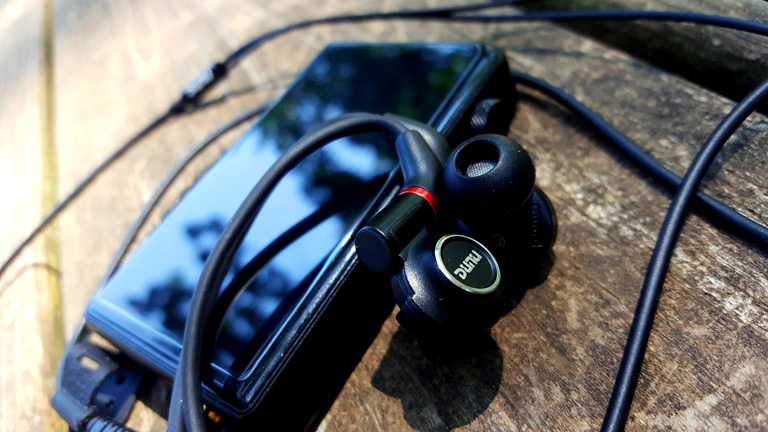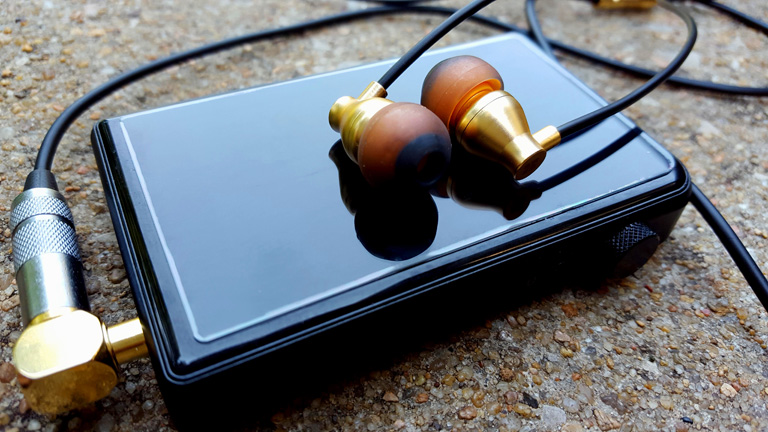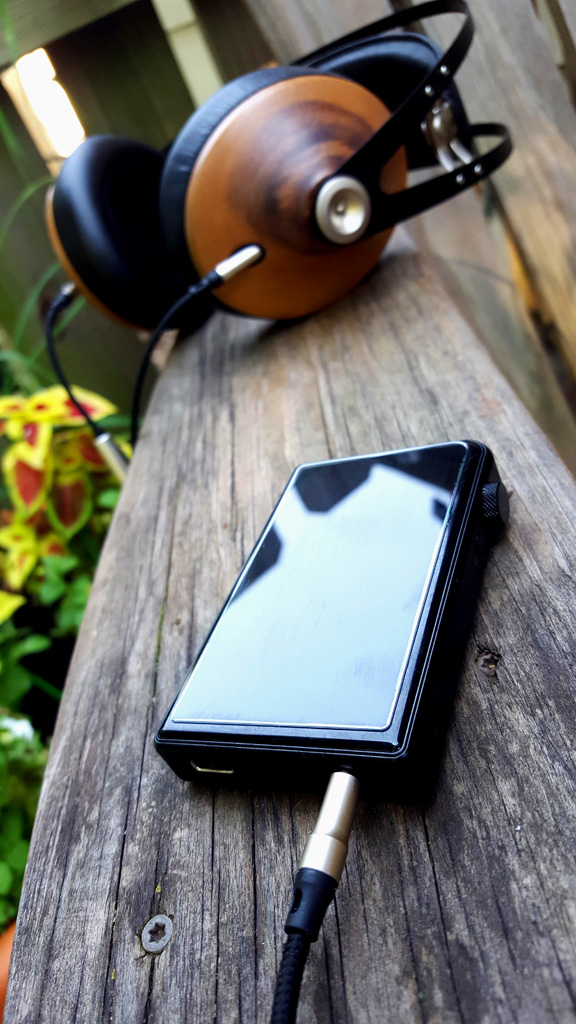
The Shanling M2s produces a smooth, analogue sound. It leans heavily towards a warm tonality, yet maintains decent levels of clarity. Details are not this player’s strong suit, though it delivers the goods in its own fashion. Musicality is where the M2s really shines. Soundstage width is decent, but unremarkable. Depth and layering is practically nonexistent.
The treble has proper presence and energy, which keeps this DAP from becoming too dark or lacking dynamics. It helps to deliver the details and separation of elements. But it’s controlled, and probably not all that extended. Basically, it’s enough, but not too much. Shanling manages an artful balance.
Vocals are smooth and clear, yet lack a little weight, coming off slightly thin. This is not a bad thing at all, just an observation. My favorite mid-tier player also has this characteristic, the Opus#1. Shanling’s M2s, however, is certainly warmer and “richer” sounding.
It packs a mean wallop in the bass department, clearly emphasizing the lows over the rest. They aren’t the most controlled or textured, but they get the job done, adding color to the profile, and making this a very fun listen. The M2s can turn even the most clinical phones into a romantic. This reminds me a lot of the Cayin i5 in that regard. In fact, due to its abundance of features and great driving power, I see the M2s as an i5-lite.

So allow me to roll right into my first comparison. The Cayin i5… it is bigger and better in every way to the M2s. But that’s okay. These exist in two very different price brackets. If you’re on a tight-ass budget, the M2s is a great compromise. It’s a little less refined. There’s not as much depth or dynamism. The soundsage is a tad smaller. The Cayin i5 is smoother and richer, but the M2s does not trail far behind. They share the same thick warmth, and meaty low-end, with that delightful treble energy.
I had hoped to have the Cayin N3 on-hand for this review, so I could do a thorough comparison. But it’s still out on tour, so I’ll have to update this article later.
Instead, let’s do another mid-tier player. It’s just not fair to put the M2s against the Opus#2, or the AK120II, or AK KANN. But the Opus#1 is not too far off in price. Especially lately. In fact, after extensive A/B testing, using a line switcher for immediate changes, I have to say, the Shanling M2s does quite well against my favorite sub-$800 DAP. The Opus#1 has better soundstage width, and MUCH better depth. It renders a cleaner, even smoother sound. Transparency is a notch or two higher. Opus is more neutral, whereas Shanling is warmer. The Opus gives you a better sense of resolution and details, and has greater dynamism. Its treble sparkles, and extends farther. The M2s has more bass quantity, and significantly more driving power. But honestly, the differences between these two can be hard to discern. It’s all a matter of degrees.

The DUNU DK-3001 is a warm, smooth, sex machine. If only it wasn’t physically painful to have in your ears. But whatever! Its sonic character melds beautifully with the Shanling. That dynamic driver takes the Shanling’s beefed up bass and flourishes. Treble has enough presence to achieve a good airy quality up top. DUNU basks in the mid-range smoothness and clarity of the player, being one of the DK-3001’s best virtues. The grandiose soundstage of this IEM compensates for the less-than-impressive auditory dimensions of the DAP. It all makes for a soothing, laid-back listen that simply melts in your ears.

Unlike the DUNU, the HiFiMAN RE800 is picky of the source gear. If the device has too much treble energy, it can exacerbate the RE800’s serious 8Khz spike and make them overly bright, sibliant, and fatiguing. Thankfully, the Shanling M2s has good control over its highs. My test for this is Salvatore Accardo – Antonio Vivaldi Le Quattro Stagioni, in DSD. If the RE800 remains pure and smooth in those high frequencies, you know you’ve found a good source for these IEMs. The HiFiMAN has a naturally crystalline, slightly thin, and quite airy quality. As such, the best pairing is a DAP with extra note weight, and immense richness. The M2s lacks the weight of my bigger players, but it has the richness to really fill out these IEMs. And of course, as much bass as you can push on a brightish-sounding headphone, the better, and the M2s has that covered. Finally, the RE800 needs a bit of juice to get them going. They require more amperage than the full-size Meze 99 Classics. Again, Shanling’s little M2s is possessed of an abundance of power, and has no trouble bringing the RE800 to flower.
Speaking of the Meze 99 Classics… these are a safe headphone for just about any source you can name. That’s what comes of perfect tuning. They are warm, but airy. Smooth, but clear as glass. They have wonderful bass, but also great treble extension and sparkle. And the vocals? Transparent as f**k. Since they scale so bloody well, I personally feel they deserve the best DAC you can afford. The 99C will sound better if you give it better. But the M2s is a fine choice if you’re looking for a genuinely reasonable solution. These are the headphones I use to do the majority of my DAP comparisons, including the ones I did earlier. They are my reference monitors, even though they don’t fit the traditional reference curve. They are capable of highlighting the slightest change in timbre, soundstage, or transparency. To this end, I know the Shanling M2s is a stalwart competitor. It celebrates much of Meze’s strengths and does little to hold them back.

The biggest surprise of all is how well the Massdrop + Sennheiser HD6XX sounds on this tiny music player. It’s REALLY nice! More than enough power. That overdone low-end of the M2s fills out the HD6XX to the extent you don’t sense any real lack. It sounds “complete”, more or less. The coupling is warm and clean, with lush, vivid mids and a healthy glimmer in the high range.

So what of the impedance-matching issue of the original M2? Well, currently my most sensitive IEMs are the Kaiser Encore by Noble Audio. At 34/100 on the volume wheel (that’s low gain), they are good and loud. So… yeah, they be sensitive f**kers. First off, there is almost no hiss. Maybe some low-level noise, but it’s hard to tell. That’s how little we’re talking. And as to the impedance, they reduced it by small percent. You wouldn’t think it’d be enough to matter, but Encore pairs flawlessly. It doesn’t freak out and get dark and muddy like Angie did on the 1st Gen model. However, I can’t exactly recommend Encore for the Shanling M2s. At $1,850, it is the most detailed, transparent, clear IEM I’ve ever heard, with top-level soundstage and imaging. The M2s simply doesn’t do it justice. I recommend the Opus#2, if funds are of no concern.




13 Responses
M2s. The audio quality is on par with iPhone 4/5/6. Low/High Gain modes are equal from SQ perspective. Steep lowpass filter should be preferred. One minor tech. issue spotted. Audio measurements that matter – http://soundexpert.org/articles/-/blogs/audio-quality-of-shanling-m2s
I don’t recall if I ever transferred any files over while the card was inside the M2s. I just put in my 128GB microSD, full of FLAC files (in properly formatted folders), and Shanling had no trouble reading those files.
If worse comes to worse, you can format your card in the player, take the card out, and use an SD reader to load it up from your computer. Then just put it back in.
The presentation and support for the MPs is shockingly bad. The instructions are minimal and virtually unintelligible, tracks downloaded from a PC (using any number of software solutions) end up as unidentified, meaning the player is useless. It only just works with MP3 files, meaning that all the high specs are little short of useless fluff. It’s shockingly bad,
.
Thanks for pointing that out.
When I’m writing, I don’t like to break my flow by scouring the net for numbers. Usually I’ll do that after, during the editing process. Sometimes certain things are simply missed.
The 7 Ohm output was me trying to remember from nearly two years when I reviewed the M2. I always meant to double check that, but it got passed me.
As for my experiencing with the M2s… it sounds fine on all my IEMs. Since the output impedance is nearly the same on both players, I don’t know why that is. Sadly I don’t have Angie around anymore for me to see how she handles the new Shanling.
Shanling M2 has 4.9 Ohm output impedance, not 7.
Shanling M2s has 4.6 Ohm output impedance.
And you said that M2s has no matching issues, lol. I already have no confidence in your review.
I have not heard the RE600. In fact, this is my first exposure to HiFiMAN, period.
From my experience, a device like the M2s will deliver a noticeable improvement in sound quality over any smartphone, or computer.
It’s heartfelt bullocks, and I do it all for you, my loyal readers. 😉
Hey there.. without a point of reference (atleast the options I can afford) it is hard for me to understand how this would sound. I am looking at this player for my vsonic gr07. My surface book drives the gr07 plenty well with decent depth and very good extension.. Atleast to my standards that is (yeah I haven’t heard the greater iems/headphones tho I did own an entry fi hd598 before gr07)…this is the problem I am facing out of this review since I can’t see any way to compare with what I have. I don’t like the way my OnePlus 3 sounds. It’s not terrible but I wish for better. It is midbassy with not good extension so lacking proper low end and bad hazy stereo image(I love the phone for things I other than sound). So all I want is the dap to sound atleast as good as the surface book (which has a fairly weak amp but clean btw). Things I love about gr07.
1. Imaging (atleast compared to what I have heard)
2. Lack of grain (except in treble region where there is minor ringing).
3. Fairly linear but extended low end without much bloat..
I don’t necessarily desire a warm sound or anything like that. I like any tonality as long as it has nice detail layering extension and imaging and doesn’t have much peaks and dips.
Do you think the shanling m2s would fit my needs well?
“Depth and layering is practically nonexistent.”
Fuck me, pinkypoofter talks bollocks again.
Hey Man you think re 800 is Good upgrade re600 ? I have qp1r and Perfect synergy with 600.
Hopefully I’ll get the N3 back pretty soon. I spent a little time with it before sending it on its way for the North American Tour. It was quite good, but that was weeks and weeks ago. I don’t remember enough of how it sounds to make a proper comparison.
After the tour is over, the agreement is for it to come back my way, and I’ll do a review of it then.
I have recently reviewed the Cayin N3 as part of the European tour. I strongly suggest you give it a try, as soon as you have a chance to do so. It may make you rewrite the last line of your (excellent) review, at least soundwise.